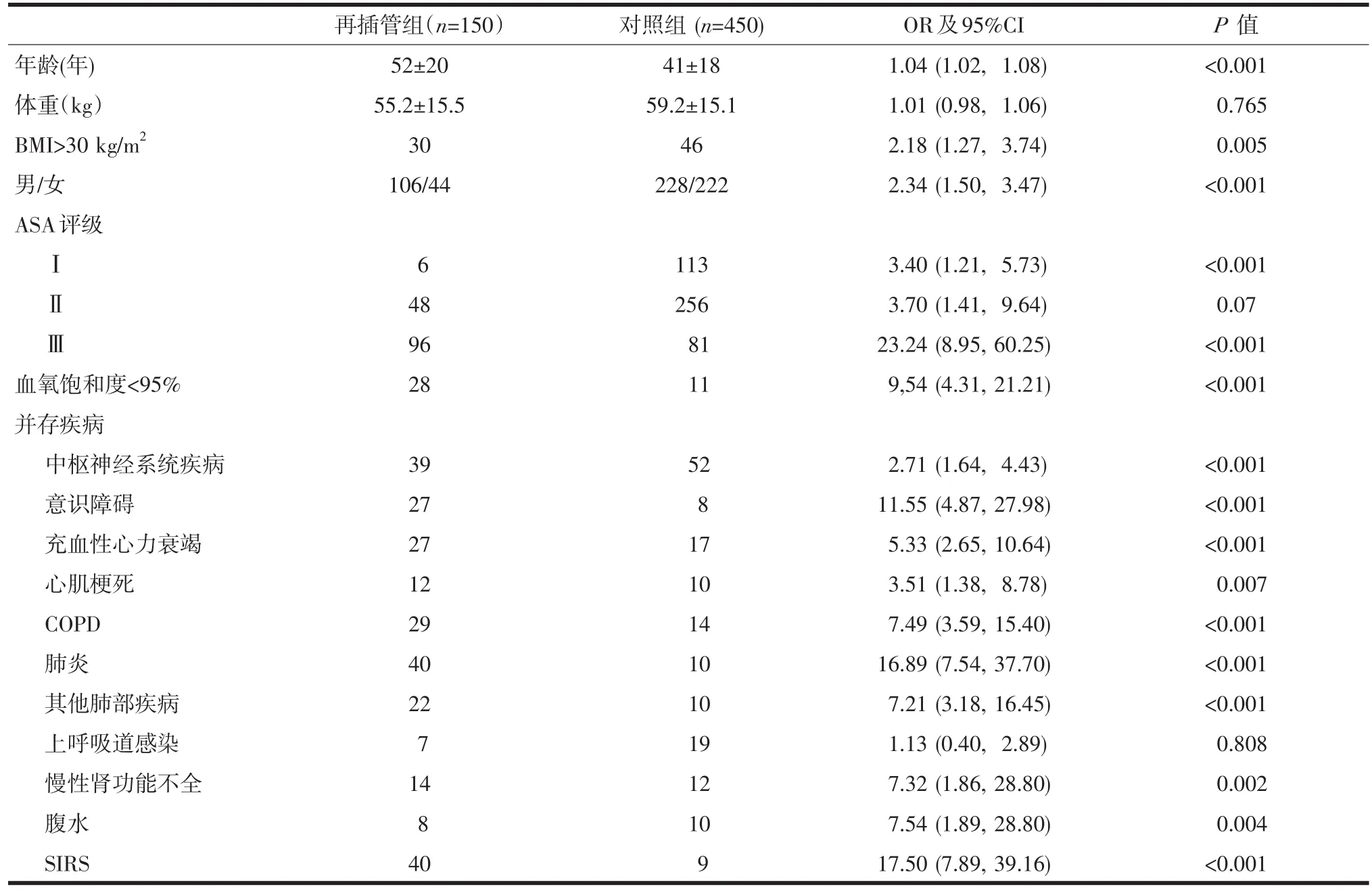全麻拔管后再插管的风险因素分析
2015-12-20李树华张晓晓
郑 瑾,李树华,张 静,张晓晓
全麻拔管后再插管的风险因素分析
郑瑾,李树华,张静,张晓晓
目的:使用Logistic回归模型评价全麻拔管后再插管的风险因素。方法:全麻手术患者600例,根据是否发生拔管后再插管,回顾性分为插管组(150例)和对照组(450例),使用单、多变量logistic回归分析患者的年龄、性别、ASA评分等及手术指标如手术类型和手术时间。结果:与拔管后再插管发生的有关因素有高龄、男性、ASA评分、肥胖、并存神经系统、心肺疾病、慢性肾功能不全、腹水或SIRS、肌松药的选择、体温过低、麻醉医师经验不足、神经系统手术和气道手术有关,ASA三级(OR=3.989,95CI:1.26,12.55)、低体温(OR=2.444,95%CI:1.25,4.78)、罗库溴铵(OR=1.897,95%CI:1.06,3.46)、气道手术(OR= 4.340,95%CI:1.44,7.62)、并存意识障碍(OR=3.506,95%CI:1.01,12.25)、COPD(OR=4.301,95%CI:1.66,10.89)、肺炎(OR= 6.611,95%CI:2.24,18.45)、腹水(OR=4.812,95%CI:0.98,23.98)、SIRS(OR=7.509,95%CI:2.66,21.70)及麻醉医师经验不足(OR= 3.341,95%CI:1.90,6.10)是独立风险因素。结论:全麻拔管后再插管的独立风险因素包括ASA评分、低体温、使用罗库溴铵、气道手术、并存意识障碍、COPD、肺炎、腹水或SIRS以及麻醉医师经验不足。
全身麻醉;风险因素;气管插管;再插管
全麻拔管后会引起肺炎、增加住院时间及增加气管切开的风险,甚至会增加死亡率[1-2]。在ICU中,评价重症患者机械通气的最佳方法,是进行自主呼吸试验,并不能准确预测患者拔管后的结局[3]。拔管后再插管的原因见于缺氧、呼吸肌疲劳、高CO2血症、上呼吸道梗阻、血流动力学不稳定[4],提示疾病的严重程度较高,同时也是患者死亡的独立风险因素之一[5]。但目前对于全麻拔管后再插管的风险因素研究较少。2007年1月—2011年12月,我们通过logistic回归模型,回顾性评价全麻拔管后再插管的独立风险因素。
1 资料与方法
1.1临床资料本组共600例,男334例,女266例;年龄(52±20)岁,研究对象为接受全麻插管手术的患者,手术类型和手术时间不限。根据是否发生拔管后再插管,回顾性分为再插管组(150例)和对照组(450例),2组的基本资料要有统计学比较。排除死亡、二次手术、失访等患者。经医院伦理委员会批准。
1.2评价指标术前评价指标包括年龄、性别、身体质量指数(BMI)、ASA分级、血氧饱和度及其他并存疾病,包括中枢神经系统疾病、意识障碍、充血性心力衰竭、心绞痛、心肌梗死、COPD、肺炎、其他肺部疾病如肺水肿和胸腔积液、慢性肾功能不全、腹水、SIRS。麻醉相关指标包括肌松药物种类、体温过低、拔管前30分钟内是否使用阿片类药物或肌松剂、麻醉医师的临床经验(将从事麻醉专业时间小于6年定义为低年资麻醉师)。手术指标包括四肢、头颈部、神经外科手术、气道手术、腹部手术及手术时间。
1.3统计分析使用SPSS 19.0统计软件对收集的数据进行分析。计数资料使用均数±标准差表示(M±SD),计量资料以频数表示。对于连续性变量以及分类变量均使用单因素logistic回归分析计算OR值及其95%CI。为进一步确认结果的可靠性及估计多变量间的协同效应,使用多因素logistic回归分析评价独立风险因素。检验水平均为P<0.05。
2 结果
再插管组150例中,再插管的原因为呼吸困难60例,气道梗阻42例,手术并发症40例,血流动力学不稳定8例。
单变量logistic回归分析结果显示,与再插管发生有关基础指标包括高龄、男性、ASA评级高、肥胖,并存神经系统疾病、心肺疾病、慢性肾功能不全、腹水以及SIRS(见表1)。有关的麻醉相关因素包括肌松药物的选择、体温过低和麻醉医师经验不足(见表2)。有关的手术因素包括神经系统手术和气道手术(见表3)。
多因素logistic回归分析显示,ASA评分三级、低体温、罗库溴铵、气道手术、并存意识障碍、COPD、肺炎、腹水、SIRS以及麻醉医师经验不足是再插管的独立风险因素(见表4)。
3 讨论
本研究使用回顾性病例对照研究的方法,评价了全麻拔管后再插管的独立风险因素。有文献报道[1,3,6],再插管的发生率约为0.17%~22.8%。本研究中,再插管率为1.35%。Ting等[7]的研究显示,与再插管发生的风险因素包括气道手术、头颈部手术、并存COPD、肺炎、腹水、SIRS。本研究结果显示,不仅上述因素与再插管有关,ASA评分三级、低体温、肌松剂罗库溴铵、麻醉医师经验不足也是发生再插管的独立风险因素。
本研究结果显示,BMI>30 kg/m2是再插管的风险因素,但不是独立风险因素。肥胖患者常伴有阻塞性睡眠呼吸暂停综合征、心血管疾病、呼吸系统疾病等。这些因素会降低肥胖患者的功能残气量和最大通气量,导致上呼吸道梗阻,因此可能增加再插管的风险。也有学者认为[8],病态肥胖会增加再插管的风险,而普通肥胖并没有增加再插管的风险。这就解释了为什么肥胖并不是发生再插管的独立风险因素。

表1 2组患者的基础指标比较(M±SD)

表2 2组患者的麻醉相关指标比较

表3 2组患者的手术相关指标比较

表4 多因素logistic回归分析结果
临床上使用肌松剂罗库溴铵用于快速气管插管,或者避免哮喘的发生。支气管哮喘患者发生拔管后呼吸系统并发症的可能性较高,可能针对这部分患者使用了罗库溴铵。另外,罗库溴铵会增加术后发生箭毒化的可能性,这就会影响患者的呼吸功能,从而增加再插管的可能性。肌松剂残留的麻痹会降低吞咽的协调性以及降低低氧通气的驱动力。患有肝功能不全或肾功能不全者,通过影响罗库溴铵代谢而增加了再插管的可能性。Maybauer等[9]的研究显示,与顺式阿曲库铵相比,罗库溴铵药效持续时间较长并存在较大的变异性。这种药代动力学的差别可能使得应用罗库溴铵会增加再插管的可能性。因此,在使用罗库溴铵后,为了提高拔管成功率,有必要使用足量的麻醉逆转药新斯的明[10]。
拔管时低体温会增加再插管的风险。全麻会损害机体的体温调节功能,低体温伴术后寒战不仅会增加机体的代谢率,还会增加心肌缺血和心律失常的风险[11]。此外,术中低体温还会增加使用肌松药后残留麻痹的风险[12]。保持围手术期体温正常,不仅能有效缩短拔管时间,减少术后寒战的发生,还能降低再插管率[13-14]。肺炎及COPD通常表现为小气道阻塞,通气阻力增加,最终会引起呼吸肌的衰竭[15]。由此可见,术前呼吸功能评估可能降低再插管的发生率。SIRS表现为发热、呼吸急促、白细胞增多。Bien等[16]的研究显示,78名经气管插管行全麻手术的患者,有26.9%脱机失败,15.4%需要再次插管。原因可能是,SIRS发病过程中内毒素对呼吸调节功能的影响[17]。严重的肝硬化伴腹水,可能通过影响机体的气体交换导致再插管的发生率增高[18-19]。
气道手术是再插管的独立风险因素之一,最主要的原因可能是气道手术引起喉头水肿,从而导致通气障碍[7]。另外一个原因是,拔管可能导致手术部位血肿形成,从而压迫气道引起呼吸困难。Eikermann等[20]的研究显示,手术后正常时间内拔管仍会引起手术部位血肿形成,引起气道梗阻。术后延迟拔管或待喉头水肿消退后拔管,可能是预防再插管的最好方法。
本研究还显示,麻醉医师的经验不足,是再插管发生的独立风险因素。对于经验不足的医师,在拔管前要充分认识到患者出现再插管的风险。丰富的临床经验有助于降低再插管的风险[21]。
本研究还存在一定的局限性:(1)研究对象的选择局限于单中心。(2)属于回顾性对照研究,可能存在一定的偏倚。(3)尚无法排除一些混杂因素的影响,如具体手术类型不同,麻醉医师经验的增长等。(4)再插管的发生率较低,可能导致假阴性结果的产生。建议针对存在上述风险因素的患者,在拔管前需制定详细的拔管策略以降低再插管的发生率。本研究结果尚需前瞻性、多中心、大样本的临床研究去验证。
[1]Thille AW,Harrois A,Schortgen F,et al.Outcomes of extubation failure in medical intensive care unit patients[J].Crit Care Med, 2011,39(12):2612-2618.
[2]Vidotto MC,Sogame LC,Gazzotti MR,et al.Implications of extuba⁃tion failure and prolonged mechanical ventilation in the postopera⁃tive period following elective intracranial surgery[J].Braz J Med Biol Res,2011,44(12):1291-1298.
[3]Savi A,Teixeira C,Silva JM,et al.Weaning predictors do not pre⁃dict extubation failure in simple-to-wean patients[J].J Crit Care, 2012,27(2):221.
[4]Chinachoti T,Poopipatpab S,Buranatrevedhya S,et al.The Thai Anesthesia Incident Monitoring Study(Thai AIMS)of post anesthet⁃ic reintubation:an analysis of 184 incident reports[J].J Med As⁃soc Thai,2008,91(11):1706-1713.
[5]Engoren M,Buderer NF,Zacharias A,et al.Variables predicting reintubation after cardiac surgical procedures[J].Ann Thorac Surg, 1999,67(3):661-665.
[6]Brown CV,Daigle JB,Foulkrod KH,et al.Risk factors associated with early reintubation in trauma patients:a prospective observa⁃tional study[J].J Trauma,2011,71(1):37-41,41-42.
[7]Ting PC,Chou AH,Yang MW,et al.Postoperative reintubation af⁃ter planned extubation:a review of 137,866 generalanesthetics from 2005 to 2007 in a Medical Center of Taiwan[J].Acta Anaes⁃thesiol Taiwan,2010,48(4):167-171.
[8]Bamgbade OA,Rutter TW,Nafiu OO,et al.Postoperative compli⁃cations in obese and nonobese patients[J].World J Surg,2007,31 (3):556-560,561.
[9]Maybauer DM,Geldner G,Blobner M,et al.Incidence and dura⁃tion of residual paralysis at the end of surgery after multiple admin⁃istrations of cisatracurium and rocuronium[J].Anaesthesia,2007,62 (1):12-17.
[10]Sauer M,Stahn A,Soltesz S,et al.The influence of residual neuro⁃muscular block on the incidence of critical respiratory events.A randomised,prospective,placebo-controlled trial[J].Eur J Anaes⁃thesiol,2011,28(12):842-848.
[11]Leslie K,Sessler D I.The implications of hypothermia for early tra⁃cheal extubation following cardiac surgery[J].J Cardiothorac Vasc Anesth,1998,12(6 Suppl 2):30-34,41-44.
[12]李建,叶卫东.单次插管剂量维库溴铵残余肌松与术中低温的关系[J].中华医学杂志,2011,91(43):3074-3076.
[13]Heier T,Caldwell JE,Sessler DI,et al.The effect of local surface and central cooling on adductor pollicis twitch tension during ni⁃trous oxide/isoflurane and nitrous oxide/fentanyl anesthesia in hu⁃ mans[J].Anesthesiology,1990,72(5):807-811.
[14]许力,赵晶,黄宇光,等.术中保温对患者核心体温的影响[J].中华外科杂志,2004,42(16):1010-1013.
[15]Lemaire F,Teboul JL,Cinotti L,et al.Acute left ventricular dys⁃function during unsuccessful weaning from mechanical ventilation [J].Anesthesiology,1988,69(2):171-179.
[16]Bien MY,Hseu SS,Yien HW,et al.Breathing pattern variability: a weaning predictor in postoperative patients recovering from sys⁃temic inflammatory response syndrome[J].Intensive Care Med, 2004,30(2):241-247.
[17]Preas HN,Jubran A,Vandivier RW,et al.Effect of endotoxin on ventilation and breath variability:role of cyclooxygenase pathway [J].Am J Respir Crit Care Med,2001,164(4):620-626.
[18]Johnson RG,Arozullah AM,Neumayer L,et al.Multivariable pre⁃dictors of postoperative respiratory failure after general and vascu⁃lar surgery:results from the patient safety in surgery study[J].J Am Coll Surg,2007,204(6):1188-1198.
[19]Piotrowski A,Sobala W,Krajewski P,et al.Ascites in infants with severe sepsis-treatment with peritoneal drainage[J].Paediatr An⁃aesth,2006,16(12):1268-1273.
[20]Eikermann M,Blobner M,Groeben H,et al.Postoperative upper airway obstruction after recovery of the train of four ratioof the adductor pollicis muscle from neuromuscular blockade[J].Anesth Analg,2006,102(3):937-942.
[21]Lin HT,Ting PC,Chang WY,et al.Predictive risk index and prog⁃nosis of postoperative reintubation after planned extubation during general anesthesia:a single-center retrospective case-controlled study in Taiwan from 2005 to 2009[J].Acta Anaesthesiol Taiwan, 2013,51(1):3-9.
(收稿:2015-01-22修回:2015-09-12)
(责任编辑李文硕)
Independent Risk Factors of Reintubation after Planned Extubation during General Anesthesia based on Logistic Regression
ZHENG Jin,LI Shu-hua,ZHANG Jing,et al.Department of Anaesthesia,Tianjin Gongan Hospital,Tianjin(300140),China
ObjectiveTo identify independent risk factors of reintubation after planned extubation. MethodsSix hundred cases underwent general anesthesia were retrospectively analyzed.Among them 150 cas⁃es sustained reintubation after planned extubation.The control group consisted of 450 patients randomly selected from those underwent endotracheal intubation without reintubation after planned extubation.Risk factors of rein⁃tubation after planned extubation cases were compared with the control group using univariate and multivariate logistic regression.ResultsUnivariate logistic regression demonstrated that the following risk factors were sig⁃ nificantly related to the reintubation after planned ex⁃tubation,including age,gender,ASA classification,BMI,nerve system diseases,cardiopulmonary diseases,chronic renal insufficiency,ascites,SIRS,rocuronium as muscle relaxant,hypothermia,inexperienced anesthetic service,airway surgery,and neurosurgery.Multivariate lo⁃gistic regression demonstrated that the independent risk factors included ASA classification,hypothermia,ro⁃curonium,airway surgery,COPD,pneumonia,conscious disturbance,ascites,SIRS,and inexperienced anesthetic service.ConclusionThe independent risk factors include ASA classification,hypothermia,rocuronium,air⁃way surgery,COPD,pneumonia,conscious disturbance,ascites,SIRS,and inexperienced anesthetic service.It is advisable to take preventive measures to reduce the risks of reintubation after planned extubation for high-risk patients.
General anesthesia;risk factors;airway extubation;reintubation
R614.2
A
1007-6948(2015)06-0584-05
10.3969/j.issn.1007-6948.2015.06.011
天津市公安医院麻醉科(天津 300042)
郑瑾,E-mail:zhengjin1998@126.com
